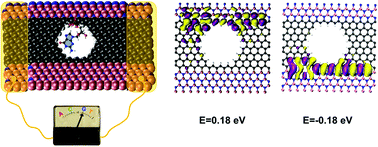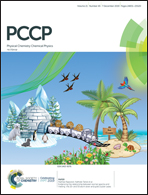Controlled current confinement in interfaced 2D nanosensor for electrical identification of DNA†
Abstract
The controlled synthesis of hybrid two-dimensional (2D) materials and the development of atomically precise nanopore fabrication techniques have opened up entirely new possibilities for sensing applications via nanoelectronics. Here, we investigate the electronic transport properties of an in-plane hybrid graphene/h-BN device, containing a graphene nanopore, to assess its feasibility to act as a molecular sensor. The results from our calculations based on density functional theory and the non-equilibrium Green's function formalism reveal the capability to confine the electric current pathways to the two carbon wires lining either edge of the nanopore, thereby creating conditions in which the conductance is highly sensitive to any changes in the electrical potential inside the nanopore. We apply this setup to assess whether it is possible to electrically determine the base sequence in a DNA molecule. Indeed, the modulation of the device conductance reveals a characteristic fingerprint of each nucleotide, which manifests itself in a pronounced difference in the sensitivity of the four different nucleotides, thereby allowing electrical discrimination. These findings lead us to propose this device architecture as a promising nanobiosensor. While fabrication in the lab may represent a profound experimental challenge, it should nevertheless in principle be feasible with existing contemporary techniques of hybrid 2D material synthesis, in conjunction with approaches for highly controlled nanopore creation.



 Please wait while we load your content...
Please wait while we load your content...